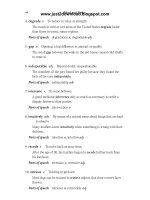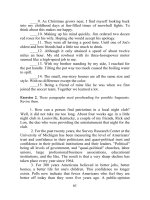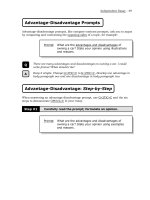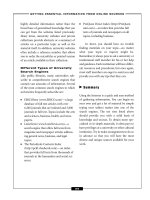Number operation review 7 doc
Bạn đang xem bản rút gọn của tài liệu. Xem và tải ngay bản đầy đủ của tài liệu tại đây (68.7 KB, 6 trang )
Now combine like terms:
Ϫ14x Ϫ 9y ϩ 18z
To multiply monomials, multiply their coefficients and multiply like variables by adding their exponents.
Example
(Ϫ4a
3
b)(6a
2
b
3
) ϭ (Ϫ4)(6)(a
3
)(a
2
)(b)(b
3
) ϭϪ24a
5
b
4
To divide monomials, divide their coefficients and divide like variables by subtracting their exponents.
Example
ᎏ
1
1
0
5
x
x
5
4
y
y
7
2
ᎏ
ϭ (
ᎏ
1
1
0
5
ᎏ
)(
ᎏ
x
x
5
4
ᎏ
)(
ᎏ
y
y
7
2
ᎏ
) ϭ
ᎏ
2x
3
y
5
ᎏ
To multiply a polynomial by a monomial, multiply each term of the polynomial by the monomial and add the
products.
Example
8x(12x Ϫ 3y ϩ 9) Distribute.
(8x)(12x) Ϫ (8x) (3y) ϩ (8x)(9) Simplify.
96x
2
Ϫ 24xy ϩ 72x
To divide a polynomial by a monomial, divide each term of the polynomial by the monomial and add the quotients.
Example
ᎏ
6x Ϫ 1
6
8y ϩ 42
ᎏ
ϭ
ᎏ
6
6
x
ᎏ
Ϫ
ᎏ
1
6
8y
ᎏ
ϩ
ᎏ
4
6
2
ᎏ
ϭ x Ϫ 3y ϩ 7
Practice Question
Which of the following is the solution to
ᎏ
1
2
8
4
x
x
8
3
y
y
5
4
ᎏ
?
a.
ᎏ
4x
3
5
y
ᎏ
b.
ᎏ
18
2
x
1
4
1
y
9
ᎏ
c. 42x
11
y
9
d.
ᎏ
3x
4
5
y
ᎏ
e.
ᎏ
x
6
5
y
ᎏ
Answer
d. To find the quotient:
ᎏ
1
2
8
4
x
x
8
3
y
y
5
4
ᎏ
Divide the coefficients and subtract the exponents.
ᎏ
3x
8 Ϫ
4
3
y
5 Ϫ 4
ᎏ
ᎏ
3x
4
5
y
1
ᎏ
ϭ
ᎏ
3x
4
5
y
ᎏ
–ALGEBRA REVIEW–
74
FOIL
The FOIL method is used when multiplying binomials. FOIL represents the order used to multiply the terms: First,
Outer, Inner, and Last. To multiply binomials, you multiply according to the FOIL order and then add the
products.
Example
(4x ϩ 2)(9x ϩ 8)
F:4x and 9x are the first pair of terms.
O:4x and 8 are the outer pair of terms.
I: 2 and 9x are the inner pair of terms.
L: 2 and 8 are the last pair of terms.
Multiply according to FOIL:
(4x)(9x) ϩ (4x)(8) ϩ (2)(9x) ϩ (2)(8) ϭ 36x
2
ϩ 32x ϩ 18x ϩ 16
Now combine like terms:
36x
2
ϩ 50x ϩ 16
Practice Question
Which of the following is the product of 7x ϩ 3 and 5x Ϫ 2?
a. 12x
2
Ϫ 6x ϩ 1
b. 35x
2
ϩ 29x Ϫ 6
c. 35x
2
ϩ x Ϫ 6
d. 35x
2
ϩ x ϩ 6
e. 35x
2
ϩ 11x Ϫ 6
Answer
c. To find the product, follow the FOIL method:
(7x ϩ 3)(5x Ϫ 2)
F:7x and 5x are the first pair of terms.
O:7x and Ϫ2 are the outer pair of terms.
I: 3 and 5x are the inner pair of terms.
L: 3 and Ϫ2 are the last pair of terms.
Now multiply according to FOIL:
(7x)(5x) ϩ (7x)(Ϫ2) ϩ (3)(5x) ϩ (3)(Ϫ2) ϭ 35x
2
Ϫ 14x ϩ 15x Ϫ 6
Now combine like terms:
35x
2
ϩ x Ϫ 6
–ALGEBRA REVIEW–
75
Factoring
Factoring is the reverse of multiplication. When multiplying, you find the product of factors. When factoring,
you find the factors of a product.
Multiplication: 3(x ϩ y) ϭ 3x ϩ 3y
Factoring: 3x ϩ 3y ϭ 3(x ϩ y)
Three Basic Types of Factoring
■
Factoring out a common monomial:
18x
2
Ϫ 9x ϭ 9x(2x Ϫ 1) ab Ϫ cb ϭ b(a Ϫ c)
■
Factoring a quadratic trinomial using FOIL in reverse:
x
2
Ϫ x Ϫ 20 ϭ (x Ϫ 4) (x ϩ 4) x
2
Ϫ 6x ϩ 9 ϭ (x Ϫ 3)(x Ϫ 3) ϭ (x Ϫ 3)
2
■
Factoring the difference between two perfect squares using the rule a
2
Ϫ b
2
ϭ (a ϩ b)(a Ϫ b):
x
2
Ϫ 81 ϭ (x ϩ 9)(x Ϫ 9) x
2
Ϫ 49 ϭ (x ϩ 7)(x Ϫ 7)
Practice Question
Which of the following expressions can be factored using the rule a
2
Ϫ b
2
ϭ (a ϩ b)(a Ϫ b) where b is an
integer?
a. x
2
Ϫ 27
b. x
2
Ϫ 40
c. x
2
Ϫ 48
d. x
2
Ϫ 64
e. x
2
Ϫ 72
Answer
d. The rule a
2
Ϫ b
2
ϭ (a ϩ b)(a Ϫ b) applies to only the difference between perfect squares. 27, 40, 48,
and 72 are not perfect squares. 64 is a perfect square, so x
2
Ϫ 64 can be factored as (x ϩ 8)(x Ϫ 8).
Using Common Factors
With some polynomials, you can determine a common factor for each term. For example, 4x is a common fac-
tor of all three terms in the polynomial 16x
4
ϩ 8x
2
ϩ 24x because it can divide evenly into each of them. To fac-
tor a polynomial with terms that have common factors, you can divide the polynomial by the known factor to
determine the second factor.
–ALGEBRA REVIEW–
76
Example
In the binomial 64x
3
ϩ 24x,8x is the greatest common factor of both terms.
Therefore, you can divide 64x
3
ϩ 24x by 8x to find the other factor.
ᎏ
64x
3
8
ϩ
x
24x
ᎏ
ϭ
ᎏ
6
8
4
x
x
3
ᎏ
ϩ
ᎏ
2
8
4
x
x
ᎏ
ϭ 8x
2
ϩ 3
Thus, factoring 64x
3
ϩ 24x results in 8x(8x
2
ϩ 3).
Practice Question
Which of the following are the factors of 56a
5
ϩ 21a?
a. 7a(8a
4
ϩ 3a)
b. 7a(8a
4
ϩ 3)
c. 3a(18a
4
ϩ 7)
d. 21a(56a
4
ϩ 1)
e. 7a(8a
5
ϩ 3a)
Answer
b. To find the factors, determine a common factor for each term of 56a
5
ϩ 21a. Both coefficients (56 and
21) can be divided by 7 and both variables can be divided by a. Therefore, a common factor is 7a. Now,
to find the second factor, divide the polynomial by the first factor:
ᎏ
56a
5
7
ϩ
a
21a
ᎏ
ᎏ
8a
5
a
ϩ
1
3a
ᎏ
Subtract exponents when dividing.
8a
5 Ϫ 1
ϩ 3a
1 Ϫ 1
8a
4
ϩ 3a
0
A base with an exponent of 0 ϭ 1.
8a
4
ϩ 3(1)
8a
4
ϩ 3
Therefore, the factors of 56a
5
ϩ 21a are 7a(8a
4
ϩ 3).
Isolating Variables Using Fractions
It may be necessary to use factoring in order to isolate a variable in an equation.
Example
If ax Ϫ c ϭ bx ϩ d, what is x in terms of a, b, c, and d?
First isolate the x terms on the same side of the equation:
ax Ϫ bx ϭ c ϩ d
Now factor out the common x term:
x(a Ϫ b) ϭ c ϩ d
Then divide both sides by a Ϫ b to isolate the variable x:
ᎏ
x(
a
a
Ϫ
Ϫ
b
b)
ᎏ
ϭ
ᎏ
a
c ϩ
Ϫ
d
b
ᎏ
Simplify:
x ϭ
ᎏ
a
c ϩ
Ϫ
d
b
ᎏ
–ALGEBRA REVIEW–
77
Practice Question
If bx ϩ 3c ϭ 6a Ϫ dx, what does x equal in terms of a, b, c, and d?
a. b Ϫ d
b. 6a Ϫ 5c Ϫ b Ϫ d
c. (6a Ϫ 5c)(b ϩ d)
d.
ᎏ
6a Ϫ
b
d Ϫ 5c
ᎏ
e.
ᎏ
6
b
a
ϩ
Ϫ
d
5c
ᎏ
Answer
e. Use factoring to isolate x:
bx ϩ 5c ϭ 6a Ϫ dx First isolate the x terms on the same side.
bx ϩ 5c ϩ dx ϭ 6a Ϫ dx ϩ dx
bx ϩ 5c ϩ dx ϭ 6a
bx ϩ 5c ϩ dx Ϫ 5c ϭ 6a Ϫ 5c Finish isolating the x terms on the same side.
bx ϩ dx ϭ 6a Ϫ 5c Now factor out the common x term.
x(b ϩ d) ϭ 6a Ϫ 5c Now divide to isolate x.
ᎏ
x(
b
b
ϩ
ϩ
d
d)
ᎏ
ϭ
ᎏ
6
b
a
ϩ
Ϫ
d
5c
ᎏ
x ϭ
ᎏ
6
b
a
ϩ
Ϫ
d
5c
ᎏ
Quadratic Trinomials
A quadratic trinomial contains an x
2
term as well as an x term. For example, x
2
Ϫ 6x ϩ 8 is a quadratic trino-
mial. You can factor quadratic trinomials by using the FOIL method in reverse.
Example
Let’s factor x
2
Ϫ 6x ϩ 8.
Start by looking at the last term in the trinomial: 8. Ask yourself, “What two integers, when multiplied together,
have a product of positive 8?” Make a mental list of these integers:
1 ϫ 8 Ϫ1 ϫϪ82 ϫ 4 Ϫ2 ϫϪ4
Next look at the middle term of the trinomial: Ϫ6x. Choose the two factors from the above list that also add
up to the coefficient Ϫ6:
Ϫ2 and Ϫ4
Now write the factors using Ϫ2 and Ϫ4:
(x Ϫ 2)(x Ϫ 4)
Use the FOIL method to double-check your answer:
(x Ϫ 2)(x Ϫ 4) ϭ x
2
Ϫ 6x ϩ 8
The answer is correct.
–ALGEBRA REVIEW–
78
Practice Question
Which of the following are the factors of z
2
Ϫ 6z ϩ 9?
a. (z ϩ 3)(z ϩ 3)
b. (z ϩ 1)(z ϩ 9)
c. (z Ϫ 1)(z Ϫ 9)
d. (z Ϫ 3)(z Ϫ 3)
e. (z ϩ 6)(z ϩ 3)
Answer
d. To find the factors, follow the FOIL method in reverse:
z
2
Ϫ 6z ϩ 9
The product of the last pair of terms equals ϩ9. There are a few possibilities for these terms: 3 and 3
(because 3 ϫ 3 ϭϩ9), Ϫ3 and Ϫ3 (because Ϫ3 ϫϪ3 ϭϩ9), 9 and 1 (because 9 ϫ 1 ϭϩ9), Ϫ9 and
Ϫ1 (because Ϫ9 ϫϪ1 ϭϩ9).
The sum of the product of the outer pair of terms and the inner pair of terms equals Ϫ6z. So we must
choose the two last terms from the list of possibilities that would add up to Ϫ6. The only possibility is
Ϫ3 and Ϫ3. Therefore, we know the last terms are Ϫ3 and Ϫ3.
The product of the first pair of terms equals z
2
. The most likely two terms for the first pair is z and z
because z ϫ z ϭ z
2
.
Therefore, the factors are (z Ϫ 3)(z Ϫ 3).
Fractions with Variables
You can work with fractions with variables the same as you would work with fractions without variables.
Example
Write
ᎏ
6
x
ᎏ
Ϫ
ᎏ
1
x
2
ᎏ
as a single fraction.
First determine the LCD of 6 and 12: The LCD is 12. Then convert each fraction into an equivalent fraction
with 12 as the denominator:
ᎏ
6
x
ᎏ
Ϫ
ᎏ
1
x
2
ᎏ
ϭ
ᎏ
6
x ϫ
ϫ
2
2
ᎏ
Ϫ
ᎏ
1
x
2
ᎏ
ϭ
ᎏ
1
2
2
x
ᎏ
Ϫ
ᎏ
1
x
2
ᎏ
Then simplify:
ᎏ
1
2
2
x
ᎏ
Ϫ
ᎏ
1
x
2
ᎏ
ϭ
ᎏ
1
x
2
ᎏ
Practice Question
Which of the following best simplifies
ᎏ
5
8
x
ᎏ
Ϫ
ᎏ
2
5
x
ᎏ
?
a.
ᎏ
4
9
0
ᎏ
b.
ᎏ
4
9
0
x
ᎏ
c.
ᎏ
5
x
ᎏ
d.
ᎏ
4
3
0
x
ᎏ
e. x
–ALGEBRA REVIEW–
79









